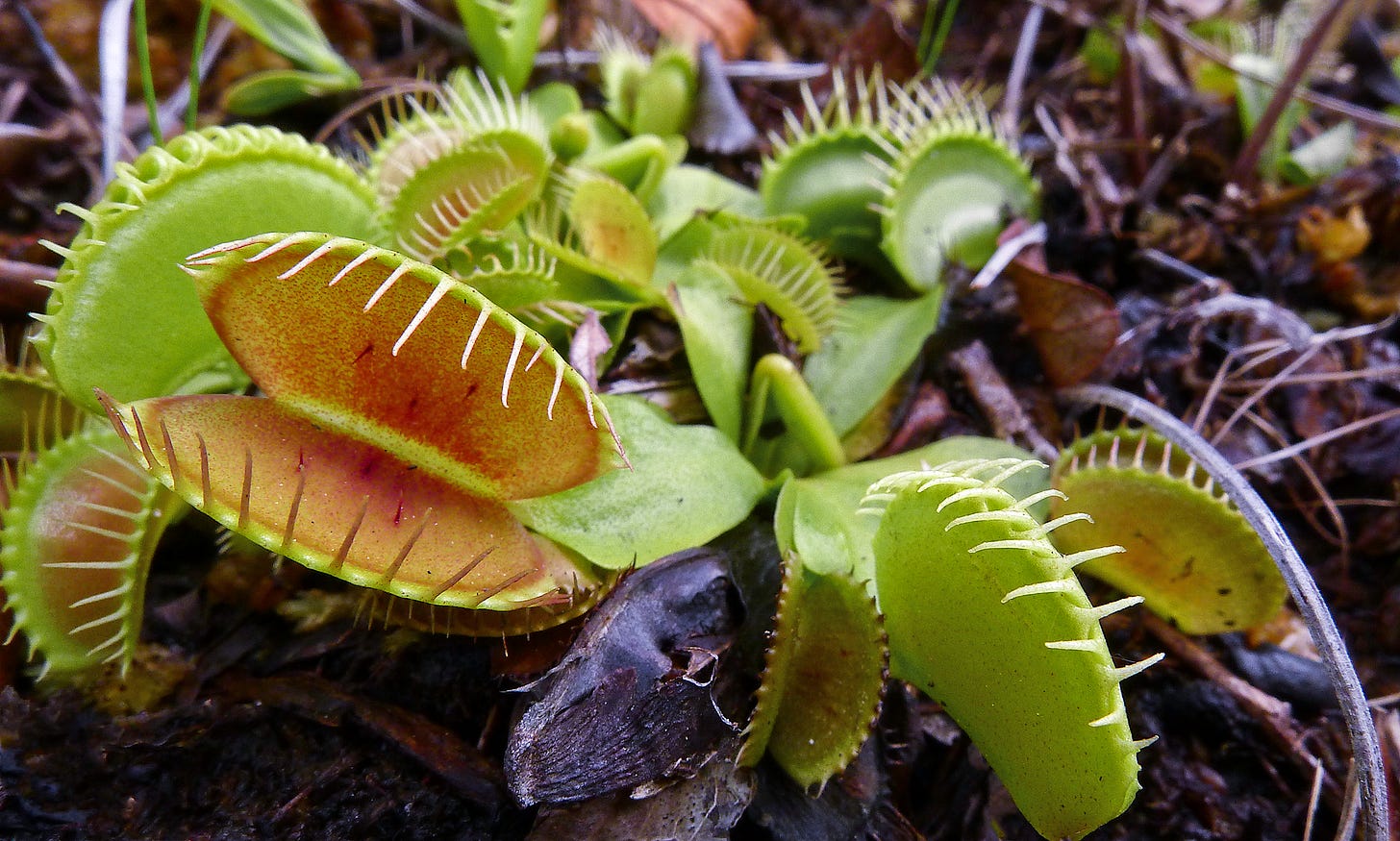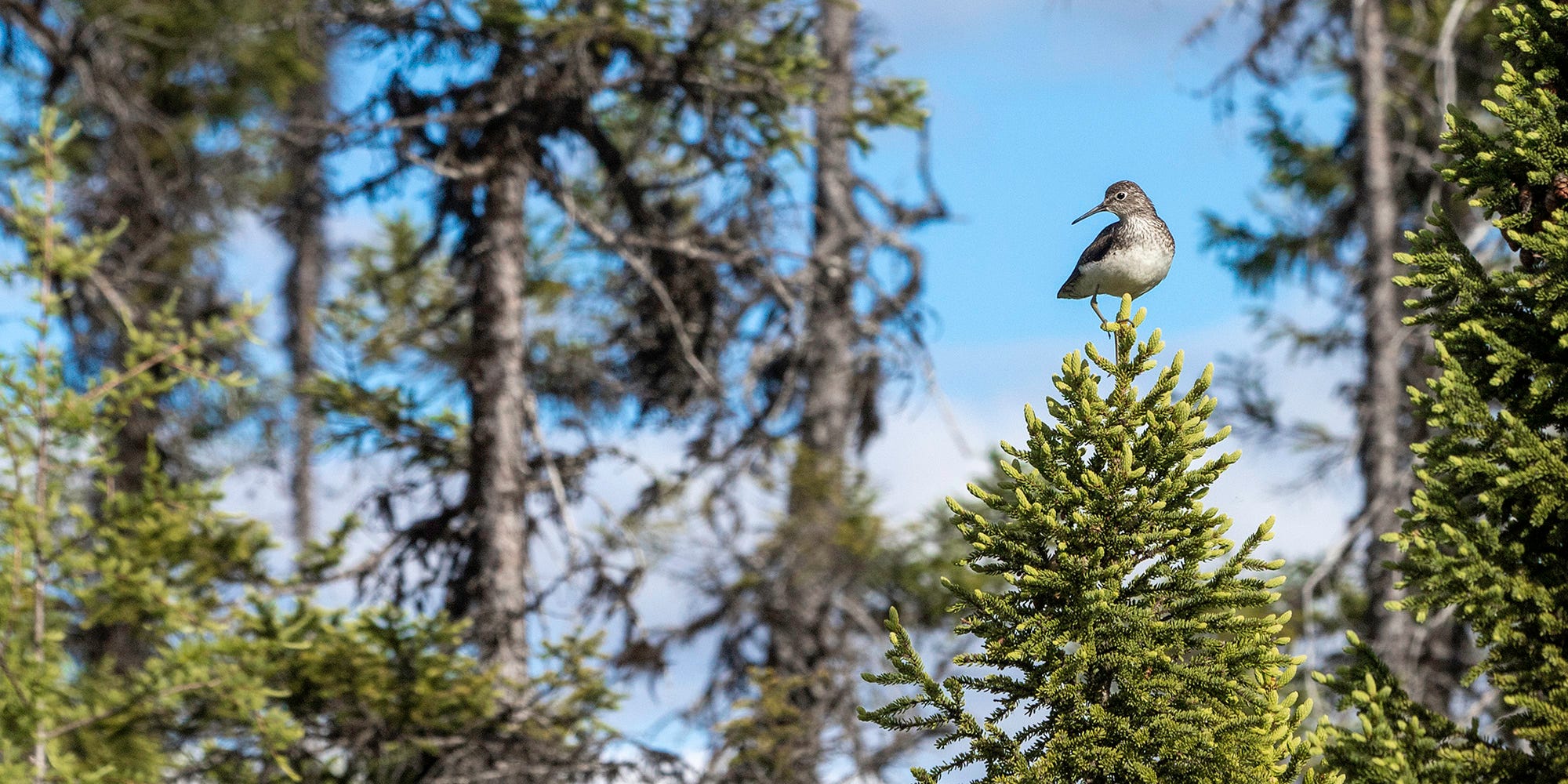A RARE and heartless killer, it dispatches and consumes its prey slowly, methodically, without forethought or remorse (and literally without a heart). Although it is famous the world around, few among us know intimately of its carnivory, and fewer still have seen it in action in its native habitat, where the killer warrants our sympathy and protection. So I myself journeyed to hallowed ground in the U.S. state of North Carolina to visit with one of the world’s most vulnerable and remarkable plants: Venus Flytrap.
It would be easy now to report for you on the antics of this plant, stuff you probably already know or can readily find online. Instead I bring you experience: what it means to encounter, in its finite and rightful place, what is mostly known as a novelty potted plant. But first a bit of evolution, a very short story of how a plant came to turn the tables on insect antagonists and evolve in an exclusive spot in the Carolinas— and nowhere else in the world.
Essential to any understanding of how Venus Flytrap (Dionaea muscipula) came to be is that plants, in their evolution, are often more parsimonious than inventive. Rather than evolving with some new appendage or other contrivance — a “jaw” to kill and digest insects, for example — plants tend to repurpose what they already have, especially leaves. The killing jaw of a Venus Flytrap is just that — a highly modified leaf. Lots of plants have changed their leaves over the course of evolution (cactus spines, for example), but Venus Flytrap and related carnivorous plants reconfigured themselves in at least two extraordinary ways:
Not only does the modified leaf, with help from sensory hairs, detect and then seize an insect or spider, it digests the prey as well. Nutrient uptake among plants, however, is normally a job for the roots. In a big evolutionary step, Venus Flytrap, for reasons that will be come clear soon, moved a good share of that duty to its leaves.
Plants variously contain chemical repellents in their tissue as protection against being eaten by insects. Venus Flytrap has repurposed those chemicals and the genes that control them — no longer for warding off insects but for digesting them instead, a kind of evolutionary shift from defense to offense.
Being There
Carnivorous plants left little evidence of this evolutionary reconfiguring in the fossil record. We understand it now by way of genomics. I sought my own understanding by visiting a patch of longleaf pine savanna in the southeastern corner of North Carolina. Scattered sites like this one, each no more than 100 miles from Wilmington, are all that remain of Venus Flytrap’s shrinking native range.
Not dense forest, and hardly open savanna, at least as many of us might envision it, the pine savanna is more park-like than primeval: open, inviting, walkable — and yet worthy of caution and tall rubber boots (wellies, muck boots, or barn boots depending on where you live or work). Well-lit and water-logged, the place is rich in venomous snakes and poor in soil nutrients.
An abundance of this kind of habitat has made the American Southeast a kind of a continental hotspot for carnivorous plants: pitcher plants in the genus Sarracenia (10 or so species), sundews in the genus Drosera (six species), butterworts in the genus Pinguicula (six species). And of course the one and only member of the Dionaea: Venus Flytrap. Nutrient-poor soils were a common force in the evolution of these carnivores, strong enough to reshape leaves into death traps and reconfigure a plant’s physiology. With their roots unable to secure enough nutrients, the plants over time evolved to seize — with their modified leaves — nutrition from what walks or flies around in the sunshine: spiders and insects. It amounts to evolution and ruthless opportunism at their finest.
Opportunity for me as well. Walking and searching carefully on those sandy, acidic soils, I understand more about Venus Flytrap’s natural community. Rare Red-cockaded Woodpeckers issue their short “churt” notes above as Northern Cottonmouths mind their business in the understory. Slow, cautious steps on my part. A Palamedes Swallowtail darts by flashing banana yellow on dark-chocolate wings. More steps into a seepy spot. Savanna Pyxiemoss in bloom does indeed resemble moss but with elfin white flowers. A few more slow steps. There it is — a rare plant pressed close to the sandy soil. Elation. Gratitude.

In its home range, Venus Flytrap reminds me that I cannot know a swallowtail or a salamander, a squirrel or a sandpiper, until I know how it lives, where it lives. In nature, context matters. During the spring and fall migrations, for example, a birdwatcher in the U.S. might encounter a Solitary Sandpiper (indeed often by itself) doing a silly walk and poking at the mud for invertebrates along lakeshores, farm ponds, riverbanks, or roadside ditches. But on its breeding grounds across Alaska and Canada, the Solitary Sandpiper does something crazy, unlike any other shorebird in North America: it nests in trees. Seeing a Solitary Sandpiper atop a Black Spruce at a bog on its breeding grounds is a revelation — like watching an entirely different bird species.
A Venus Flytrap is unusual and wonderful most anywhere it lives. It might survive in its little pot on a diet of hand-fed live insects, and perhaps even lure and consume prey on its own in the house or backyard. Potted, it is a worthy plant. But away from its genuine habitat, it is not the same plant. The same goes for the pine savanna of North Carolina — unusual and wonderful with its warblers and woodpeckers, snakes and sundews. Without Venus Flytraps, it would still be pine savanna — open, inviting, and diverse. But it wouldn’t be the same pine savanna. At least not for me.
Most people who visit and enjoy its native places will never encounter a Venus Flytrap (locations are unpublicized in order to prevent poaching). I like to think that’s not a deal-breaker, that it can be nice enough to know that the plants are out there somewhere in the pine savanna, doing their thing, doing okay.
After all, most of us also want to live in a world where human beings, whether or not we’ve ever met them, are sheltered and fed and safe from injustice. As for me, I’d like to live in a world where that is also the case for plants.
Bonus Evolutionary Biology, References, and a Sandpiper in a Tree
The sole member of its genus, Venus Flytrap is in the plant family Droseraceae, which mostly features the sundews — whose modified leaves seize prey by way of tentacles tipped with sticky drops of mucilage. It’s not too far of a stretch to see how Venus Flytrap, in its own evolution, might have descended from a sundew-like ancestor, basically by way of modification of those tentacles into spikes, and by the rest of the leaf able to snap closed around its prey. So here it is for you, the harmony of the family — a beautiful thing:
Venus Flytrap Champions — A conservation group and network of volunteers with lots of information on its website about protecting this plant on public and private lands.
U.S. Fish & Wildlife Service (USFWS) Venus Flytrap Overview Page, including the threats to its existence and how we might help.
The USFWS’s published decision (25 July 2023) not to list Venus Flytrap as endangered or threatened under provision of the Endangered Species Act of 1973; and the dissenting response from Venus Flytrap Champions and one of the 26 petitioners to have the species federally listed.









Love the picture of the juicy sundew. I find them growing of floating “log gardens” in Adirondack lakes. It’s like going on an egg hunt!
That last set of photos! How gorgeous. I met some sundews last autumn in a fen, which was the coolest experience. I've never seen photos of Venus Flytraps in the wild I don't think -- it feels totally different looking at them that way. Thank you for sharing!